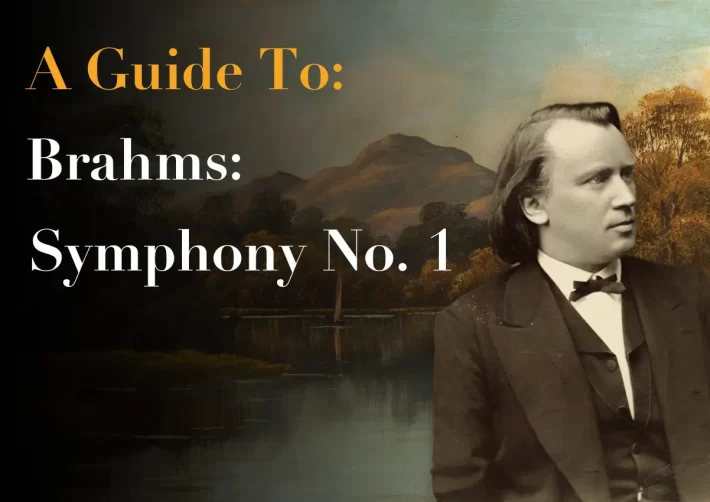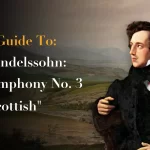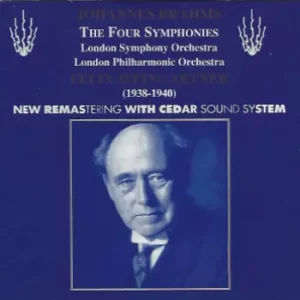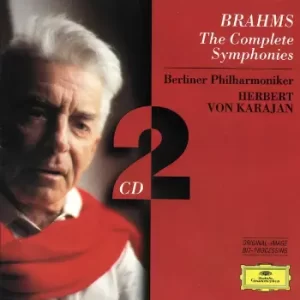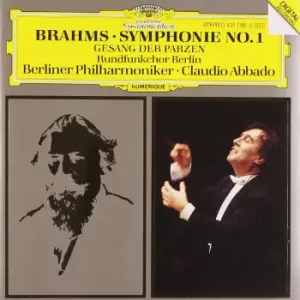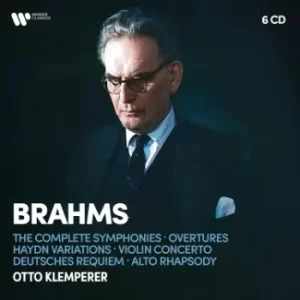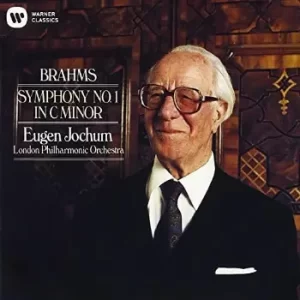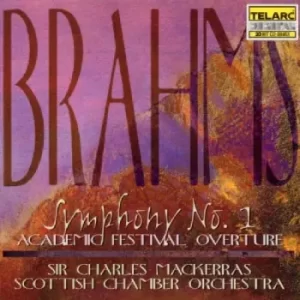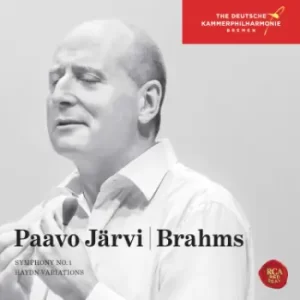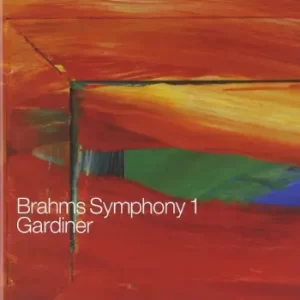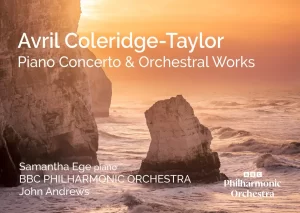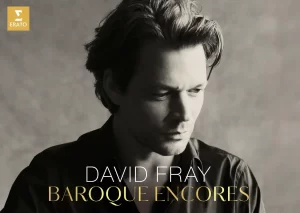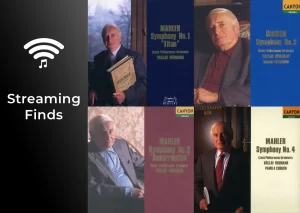Brahms was 43 years old when his first symphony premiered in Karlsruhe in 1876. Its composition took at least fourteen years, though some scholars believe Brahms, at the urging of Robert Schumann, began his work as early as 1855. Why did it take so long? Mostly because of the esteem with which Brahms (and so many other composers of the period) held the symphonies of Beethoven. “I shall never write a symphony” Brahms once told a friend, “You have no idea how the likes of us feel when we hear the tramp of a giant like him behind us.”
Yet Brahms always intended to write a symphony, and the orchestral works written before 1876 (Piano Concerto No. 1, the two Serenades the arrangement of his “Haydn Variations”) can be viewed, at least in part, as Brahms’ effort to master orchestration and symphonic thinking. Even after the symphony’s successful first performance and mostly positive reactions from critics, Brahms continued to tinker, making a significant revision to the second movement just before the score’s engraving in 1877. The result is an undisputed masterpiece which established a new path for the Romantic symphony.
Brahms – Symphony No. 1 – Analysis
Key to Brahms’ compositional style is “developing variation,” the process in which musical material is continually varied and developed. Brahms uses sonata form in the symphony’s outer movements, a widely used structure during the classical period. A fundamental aspect of this form is literal repetition. The exposition, in which the theme/s are first presented, always repeated before moving on to the Development. The Recapitulation (the section that follows the Development) is expected to present the first theme exactly as it was heard in the Exposition. But Brahms has little use for literal repetition. Instead, once he presents a theme, he almost immediately begins to vary and develop it. In Brahms’ music, the clearly delineated sections and symmetry so beloved in the Classical period are often muddied or ignored all together. While this article cannot hope to point out every variation, it will hopefully give the reader a sense of what Brahms is up to in each movement.
Editor’s note: Timings is taken from performance by The Deutsche Kammerphilharmonie Bremen and Paavo Järvi, mentioned as one of the top recommendations below:
Movement I
The slow C-Minor introduction is a complex web of conflicting ideas: timpani ominously pound away on repeated Cs, while a rising phrase in violins (IDEA A) struggles against a descending stepwise phrase in woodwinds (IDEA B). After arrival at a strong cadence (0’33”), a sighing motive (IDEA C) is introduced, followed by an arpeggiated triadic motive (IDEA D, 1’26”). The opening music (subtly reorchestrated), quickly arriving at another cadence, after which solo oboe and cellos create a more forlorn atmosphere that leads right to the Allegro.
Each theme of the Allegro has its roots in the slow introduction: the three-note motive heard in the woodwinds (derived from IDEA A), answered by a melody in the strings that expands IDEA D. This flows into a passage of sighing motives (derived from IDEA C). These motives are worked with until a moment of wistful calm is reached (4’46”). Violas suddenly introduce a snarky three-note motive that quickly moves to the violins, who add a fourth note making the rhythm SHORT-SHORT-SHORT-LONG (the same rhythm used throughout Beethoven’s fifth symphony). This figure drives the music forward, growing more menacing until it is stopped by the descending two-note figure (5’38”) with which the Exposition ends.
The Development begins (8’52”) with the upper and lower strings in canon, playing a motif derived from IDEA D. Violas again disrupt with their three-note motive, quickly taken up by violins who make it S-S-S-L. Motives based on IDEAS C and B then struggle for dominance, and by 10’30” IDEA B, played by woodwinds and violins, appears to have won the struggle. But at 10’56 contrabassoon and lower strings introduce an ascending line that accumulates energy, driving the music into the Recapitulation (11’54”). The Recapitulation is somewhat traditional, until the violas interrupt with their three-note motive for the final time, the music growing in power and energy until it reaches the descending two-note figure, which is greatly extended as the motif is tossed between winds and strings, reaching a point of crisis (14’40). After the climax, all tension ebbs away and there is an unexpected shift into C major for the last 17 bars.
Movement II
The “autumnal mood”, for which Brahms is known for, governs this movement. Each section (the movement’s form is ABA+Coda) features beautiful, finely spun silken melodies, but with repeated, careful listening, one hears how those melodies are often broken into smaller motives.
The hushed richness of the opening bars, strings accompanied by the bassoons and horns (whose line reminds us of the timpani in the opening introduction) immediately sets the mood. At 1’04” the oboe, accompanied by the other winds, introduces a forlorn melody (build from a S-S-S-L pattern); as the phrase comes to its end, strings enter with their music from the beginning (1’21”) – a lovely dovetailing of melodic material. The B section begins (1’45”) as the opening violin theme expands into a continually ascending triadic figure that crests in the first forte passage of the movement. The oboe gently steals in (2’23”), its line then echoed by the clarinet, and then the lower strings, answered by an increase in volume and rhythmic complexity that is the music’s most impassioned outpouring. The A section returns (4’07”), the melody heard in the woodwinds, accompanied by far more rhythmic activity in the strings. The Coda, built around solos for horn and violin, establishes a moment of gentle bliss.
Movement III
Like the previous movement, this is in ABA+CODA form, and Brahms’ asks that the music be played “a little bit fast and graciously.” The opening clarinet phrase (5 bars) is answered by another 5-bar clarinet phrase which is an exact inversion of the first phrase – a nod to the composer’s love of Baroque compositional technique. The theme is then repeated by violins accompanied by the first clarinet’s countermelody, leading into a more agitated section that quickly peters out. The B section (1’37”) brings a shift from simple to compound meter (2/4 to 6/8) and a new, brighter key; the basic material is three repeated notes or chords in the winds which begin off the beat, alternating with descending arpeggiated chords in the strings. The material is constantly varied, building steadily towards a small climax that quickly winds down to the return of the A section (2’49”). Brahms asks that the Coda becomes more and more tranquil, another gentle and delicate ending.
Movement IV
Once again, the slow introduction contains the key ingredients for what we will hear over the course of the movement. Take note of the opening descending four-note figure in the lower strings, as well as the first violin phrase. At first solemn and mysterious, the music gradually builds in intensity and complexity, leading to an angst-ridden climax at 2’36.” The horns then play the Alpine melody Brahms had copied down and sent to Clara Schumann in 1868, writing under the notes “High on the hill, deep in the dale, I send you a thousand greetings!” Fragments of the horn call are played by various instruments until 3’59,” where trombones and bassoons play what sounds like a Lutheran chorale. The Alpine melody returns, leading us right into the Allegro proper.
This is the theme (5’03”) that many were quick to point out sounded very much like the Ode to Joy theme in Beethoven’s Ninth. (Brahms was quick to respond – “Any ass can see that.”) The theme, first played by the strings, is then repeated by the woodwinds and then full orchestra (Beethoven presents his “Joy” theme similarly in the ninth symphony). Brahms quickly leaves the nobility of this music behind, the theme fragments against scurrying scales in the strings and woodwinds. The chromatic and animated second theme is heard in the first violins (6’42”), accompanied by the four-note descending bass line we heard in the slow introduction. At 7’45” a triplet figure appears that quickly pervades every orchestral line, leading back to a reprise of the first theme (8’43”).
The Recapitulation should be a literal restatement of the material we heard at the beginning of the Allegro, but here it is not. The woodwinds accompany the melody with staccato interjections, and when the when the winds try to take the theme over from the strings, the melody is fragmented as the harmonies become more chromatic. In fact, from this point on the music is in a constant state of development until the Coda – Brahms is combing the Development and Recapitulation into one section
As rhythms become increasingly syncopated and busy, the bustling energy drive the music towards its most overwhelming climax (11’42”). The Alpine horn returns to establish a sense of calm (and note the return of the timpani tattoo heard in the first movement’s introduction) The music then further develops the second theme (12’40”) and the triplet figure (13’48”), which propels the music to the Coda. The Lutheran Chorale theme returns (15’32”), victoriously sounded by the full orchestra, leading into the final minute, a true tour de force for the orchestra and an exultant celebration of C major.
Brahms – Symphony No. 1 – The Best Recordings
London Philharmonic Orchestra, Felix Weingartner
The Weingartner recording is, admittedly, difficult to track down, but there is convincing evidence that Brahms’ heard and admired Weingartner’s performances of his symphonies. The most notable element of Weingartner’s performance of the first Symphony is the fast and steady tempi choices, that sound exciting yet never lose their flexibility. The 1938-1940 recordings may be an insurmountable obstacle for some, so the next place to look for an admiringly Weingartner admirer is Ricardo Chailly, in his cycle of the complete Symphonies and Serenades with the Gewandhaus Orchestra. Chailly studied Weingartner’s recordings before setting down his second cycle, resulting in lean, rhythmically powerful readings. Very well recorded too.
Berlin Philharmonic Orchestra, Herbert von Karajan, Claudio Abbado
The Berlin Philharmonic has probably recorded the Brahms’ symphonies more than any other orchestra. Karajan’s cycle from the 1970s is excellent and his reading of the first symphony is exceptionally powerful. Abbado’s cycle, one of the first projects produced after he took the reins from Karajan, is equally successful, with more impressive sound (and some wonderful performances of Brahms’ choral works).
Philharmonia Orchestra, Otto Klemperer
Klemperer’s reading of the First Symphony is made of granite, implacable and grimly powerful, and is the most successful from his complete (and wonderful) cycle for EMI from the late 1950s.
London Philharmonic Orchestra, Eugen Jochum
Jochum’s reading is wildly impulsive, his flexibility of pulse always convincing, and the concluding minutes of the first symphony will lift you out of your seat. The performances of the Third Symphony, a part of this set, is one of the best on record.
Scottish Chamber Orchestra & Charles Mackerras
Mackerras was one of the first to offer a historically informed approach. These readings incorporate notes on interpretations by Fritz Steinbach, who modeled his conducting of these works on performances Brahms’ conducted. Mackerras also uses an orchestra the size of the Meiningen Orchestra that premiered the fourth symphony (roughly 50-60 players). Mackerras’ flexibility of tempo and powerful wind sound are highlights of the set.
The Deutsche Kammerphilharmonie Bremen, Paavo Järvi
Jarvi’s more recent set is perhaps the best of a slew of recent recordings that play with historically informed performance practice.
Orchestre Révolutionnaire et Romantique, John Eliot Gardiner
Hearing this symphony on the instruments on Brahms’ day, especially with the visceral force which Gardiner and his players brings to their performance, is something all lovers of Brahms, and this symphony, should hear.

Support Us
We hope this guide has helped you navigate the wonderful world of classical music! If you enjoyed this free resource, consider making a donation to The Classic Review. Your generosity helps us keep the music playing by allowing us to publish informative guides, and insightful reviews. Every contribution, big or small, allows us to continue sharing our passion for classical music with readers like you.
Donate Here
Included with an Apple Music subscription:
Available on Presto Music
Latest Classical Music Posts
Read more classical music reviews or visit The Classic Review Amazon store
Follow Us and Comment:
[wd_hustle id=”HustlePostEmbed” type=”embedded”]

